#bleu de lyon
Explore tagged Tumblr posts
Text

Restaurant Le Train Bleu, Paris, France: Le Train Bleu ("The Blue Train") is a restaurant located in the hall of the Gare de Lyon railway station in Paris, France. It was designated a Monument Historique in 1972. The restaurant was originally created for the Exposition Universelle (1900). Each ornate dining room is themed to represent cities and regions of France and they are decorated with 41 paintings by some of the most popular artists of that time. Wikipedia
#Restaurant Le Train Bleu#Gare de Lyon#Place Louis Armand#12th arrondissement#Paris#France#ile de france#europe
571 notes
·
View notes
Text
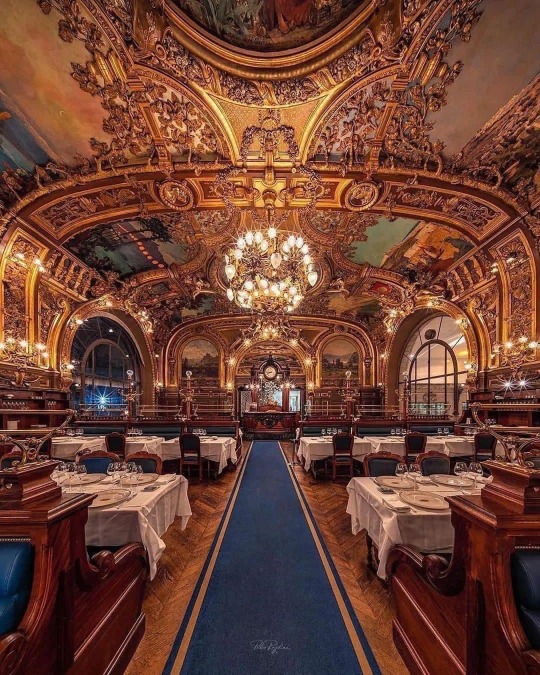
Le Train Bleu is an iconic restaurant is located inside the train station Gare de Lyon in Paris.
It was in 1900 at the time of the Universal Exhibition, when the station buffet was built. Later it became the legendary restaurant Le Train Bleu.
Marius Toudoire, the famous architect behind the Gare de Lyon clock tower and façade, was entrusted with carring out these works.
126 notes
·
View notes
Text

Décor urbain.
Pointe diamant
#photographie urbaine#urban photography#couleurs urbaines#urban colors#décor urbain#urban decor#bleu#blue#rue de montoban#vieux lyon#69005#lyon#rhône#auvergne rhône alpes#france#photographers on tumblr#poltredlyon#monlyon#onlylyon#igerslyon#lyonurb#brumpicts#frédéric brumby
45 notes
·
View notes
Photo




La Femme Nikita - Nikita (1990)
#1990#gif#film#movie#La Femme Nikita#Nikita#Luc Besson#Anne Parillaud#Marie Clement#Tcheky Karyo#Bob#Jean-Hugues Anglade#Marco#Jean Reno#Victor#Victor le nettoyeur#Victor the Cleaner#Restaurant Le Train Bleu#Gare de Lyon#Paris#France#Desert Eagle#Mark I#assassin
131 notes
·
View notes
Photo
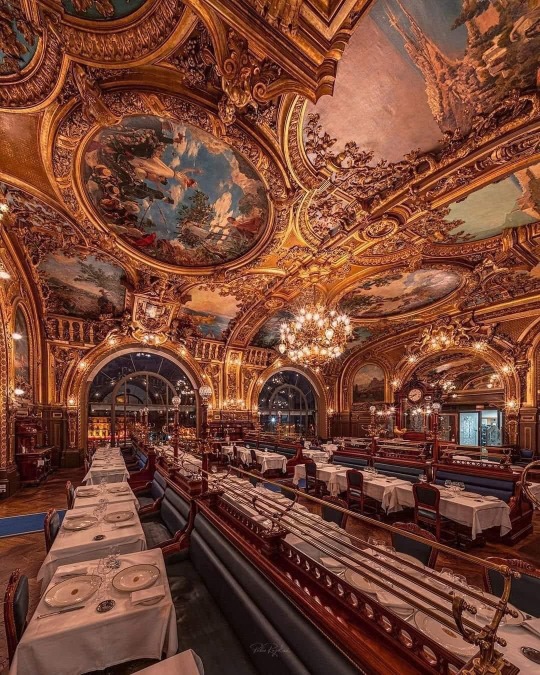
Restaurant Le Train Bleu, Gare de Lyon, 75012 Paris, France. - source Aneta Frackowska Design.
142 notes
·
View notes
Text
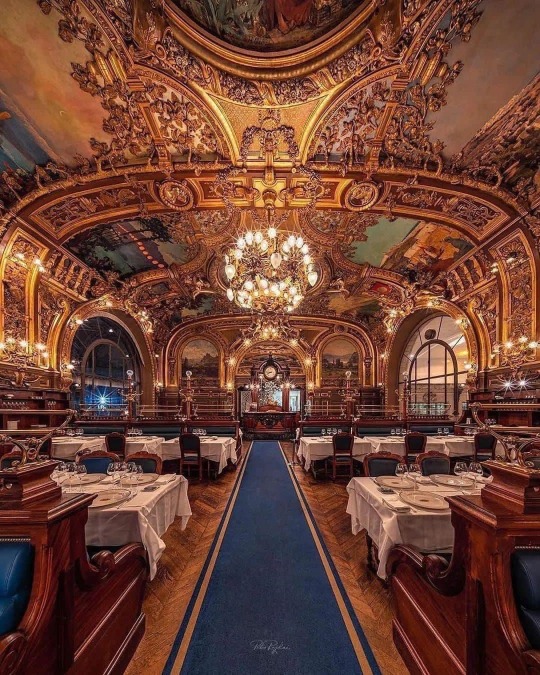
Le Train Bleu is an iconic restaurant is located inside the train station Gare de Lyon in Paris.
It was in 1900 at the time of the Universal Exhibition, when the station buffet was built. Later it became the legendary restaurant Le Train Bleu.
Marius Toudoire, the famous architect behind the Gare de Lyon clock tower and façade, was entrusted with carring out these works.
6 notes
·
View notes
Text









French Train Station interior
Lyon Perrache (1982)
Vaudreuil Ville Nouvelle (1978)
Strasbourg (1988)
Souillac (1984)
Macon (1982)
Paris Gare de Lyon Train Bleu (1982)
Marseille Saint Charles (1985)
Lille Flandres (1979)
Lyon Part-Dieu (1983)
Source : Sncf Open Archives
310 notes
·
View notes
Text

Jean-Philippe Veron
Le train bleu
Gare de Lyon, Paris
91 notes
·
View notes
Text
Chatte douloureuse à Poitiers : la maire féministe annonce jusqu’à 24 jours de vacances gratuits pour les 2000 femmes fonctionnaires de la ville.

Les mecs n'avaient qu'à être des femmes s'ils voulaient 12 jours de vacances à l'œil.

À Poitiers, les femmes auront droit à 3 semaines de vacances supplémentaires par an offertes par tous les contribuables.
C’est l’égalité homme-femme.
Libération :
La ville de Poitiers, dirigée par les Écologistes, a annoncé la mise en place d’un congé menstruel dès le 1er janvier 2025 pour ses 2 000 agentes. Un dispositif détaillé ce lundi 16 décembre, à l’occasion de la présentation de son rapport annuel sur l’égalité professionnelle des agentes de la collectivité de Poitiers. A l’aide d’un certificat médical, les employées de la collectivité pourront prendre un à deux jours de congé menstruel chaque mois, en cas de règles douloureuses voire d’endométriose. «Chaque agente pourra en bénéficier sans impact sur sa rémunération car il n’y aura pas de jour de carence, sans impact sur sa carrière, et sans stigmatisation possible puisque cette autorisation spéciale d’absence est noyée parmi les autres, seul le médecin en connaissant la raison», a expliqué Stéphane Allouch, adjoint au personnel et au dialogue social à la ville de Poitiers, interrogé par France Bleu Poitou. Afin de lever le tabou autour des règles, la ville a également organisé des ateliers avec des agentes de la collectivité. «La première question qui s’est posée pour elles, c’est de savoir qui allait faire leur travail si elles sont absentes, a rapporté la conseillère municipale à l’égalité des droits Alexandra Duval. Il faut déconstruire cela. Les femmes ont droit d’avoir des conditions de travail adaptées.»
Ils vont déconstruire, mais ça ne répond pas à la question : qui va bosser à leur place ?
La réponse est simple : personne.
Parce qu’elles ne foutent rien pour commencer.
Celles qui ont posé cette question avaient peur de se faire réquisitionner pour remplacer leurs collègues, mais évidemment ce n’est pas à l’ordre du jour.
Poitiers suit l’exemple d’autres municipalités. La première d’entre elles, Saint-Ouen-sur-Seine (Seine-Saint-Denis), a été la première ville française à mettre en place le congé menstruel, proposant jusqu’à deux journées par mois et sans carence à ses administrées. L’expérimentation avait été lancée le lundi 27 mars 2023. Depuis, d’autres collectivités ont pris le train en marche. C’est le cas de l’Eurométropole de Strasbourg, qui permet, depuis le 1er septembre 2024, à ses 3 500 agentes de bénéficier d’un «congé de santé gynécologique», soit treize jours d’absence exceptionnelle par an. Il y a deux mois, le 17 octobre, ce fut au tour de la commune de Barentin, en Seine-Maritime, de proposer à ses employées ce congé particulier. On peut également nommer Lyon, Nantes, Châlette-sur-Loing dans le Loiret, Orvault en Loire-Atlantique ou encore Abbeville dans les Hauts-de-France. Mais ce congé menstruel ne dépend pas du simple bon vouloir des mairies. Le 20 novembre dernier, la ville de Plaisance-du-Touch en Haute-Garonne, son centre communal d’action sociale ainsi que la communauté de communes du Grand Ouest Toulousain se sont heurtés à une réalité juridique : l’absence d’un cadre législatif, alors que le préfet local avait saisi le tribunal administratif pour demander l’annulation du dispositif. «Le tribunal estime que ces collectivités territoriales n’ont pas le pouvoir de prendre ce genre de décisions en l’absence de dispositions législatives ou réglementaires», avait rapporté France Bleu Occitanie.
À Poitiers, comptez 1,5 jour pour chacune des 2000 fonctionnaires de sexe féminin de la commune concernées par la mesure, soit 3000 jours d’absence mensuels.
Si on estime que ces fonctionnaires font semblant de travailler 7 heures par jour, cela représente 21000 heures de travail qui seront facturées aux contribuables chaque mois. Pour 11 mois (hors vacances d’été), c’est 230000 heures d’absence rémunérées.
Le salaire moyen d’un fonctionnaire territorial est de 2200 euros, auquel il faut ajouter les diverses cotisations à la charge de l’État et de ses collectivités, soit au moins 3000 euros. Une heure de travail d’une de ses gonzesses coûte au strict minimum 21 euros.
21 euros x 7 heures x 3000 jours x 11 mois = 4,8 millions d’euros par an.
Le budget annuel de la ville en 2024 est de 221 millions d’euros. Cette histoire d’ovaires douloureux à dormir debout va bouffer à elle seule 2% du budget de fonctionnement de la ville.
Oubliez la gangue du marketing féministe, c’est de l’achat de votes organisé par la traînée écologiste locale. Les 2000 garces qui vont bénéficier de ces 3 semaines de vacances supplémentaires vont bien évidemment voter pour cette tarée de maire en 2026.
Qui aurait pu croire qu’élire une dinde à la mairie se transformerait en gabegie généralisée ?
À un moment donné, quand on fait tout pour, on mérite le djihadisme.

Démocratie Participative
3 notes
·
View notes
Text


~ "Le Train Bleu is a famous and luxurious restaurant located inside the Gare de Lyon train station in Paris. Opened in 1901, it was originally designed to impress travelers heading to the south of France. The restaurant is known for its opulent Belle Époque decor, with grand chandeliers, beautiful murals, and ornate ceilings that transport diners back to the elegance of the early 20th century. Le Train Bleu serves classic French cuisine, offering a taste of traditional dishes in a setting that feels like a palace. Over the years, it has hosted many famous guests, including celebrities and politicians, making it a symbol of Parisian luxury and history. Dining at Le Train Bleu is not just about the food—it's about experiencing a piece of Paris's cultural heritage in a truly magnificent setting." ~
2 notes
·
View notes
Text

Restaurant Le Train Bleu Paris, France: Le Train Bleu (“The Blue Train”) is a restaurant located in the hall of the Gare de Lyon railway station in Paris, France. It was designated a Monument Historique in 1972
4 notes
·
View notes
Text
12 novembre
j'ai du m'arracher à mes collages sur photoshop pour aller dormir ce soir. ça me rassure de pouvoir éprouver autant de plaisir à faire quelque chose. écouter de la musique aussi me procure du plaisir x1000. ce matin après avoir déjeuné je suis remontée dans ma chambre et j'ai écouté les trois premiers albums de muse par ordre décroissant assise sur mon lit. quand maman est rentrée dans ma chambre en disant qu'est-ce que tu fais là? j'avais l'impression d'avoir douze ans et d'écouter avril lavigne sur mon lecteur cd assise en tailleur sur la moquette. je me suis rendu compte à quel point muse me réconfortaient encore, presque vingt ans après, en les écoutant bien fort, ils restent un refuge. tellement d'anniversaires à fêter l'année prochaine. vingt ans de muse, vingt ans du journal, vingt ans de ma non tumeur à l'oeil. j'espère que ça va mettre en branle des forces géologiques ou des forces cosmiques ou n'importe quelles forces qui me feront sortir d'ici.
l'autre jour j'ai regardé un film sur une femme de 63 ans qui a traversé la mer à la nage entre cuba et la floride, après avoir échoué à 28, 60, 61 et 62 ans, et puis le même jour j'ai appris que jenna lyons avait embrassé une femme pour la première fois à 42 ans AND LOOK AT HER NOW, icône lesbienne en couple avec cass bird. je vais essayer d'aborder mon anniversaire avec ces deux histoires en tête.
14 novembre
j'ai fait un rêve tellement long ce matin que j'ai l'impression de m'être perdue en chemin. de m'être perdue moi je veux dire. je me suis réveillée à 11h14, je sais pas si c'est normal. tout d'un coup à la veille de mes 33 ans mon corps me dit que je suis pas SI vieille que ça et que je suis encore tout à fait capable de faire des grasses matinées. à part ça on est mardi et je me tiens absolument pas à ma nouvelle routine que j'étais censée instaurer mais c'est pas grave parce que c'est la semaine de mon anniversaire et j'ai décidé de me laisser luxurier dans mon luxe mon luxe absolu de pouvoir hiberner et me lever à 11h14 parce que c'est ce que mon corps réclame, mon luxe de pouvoir décider de ne pas sortir dehors sous la pluie et la tempête sans fin et de commencer ma journée doucement en répondant aux messages de r. de m. et d f. qui visiblement ne m'en veut pas pour dimanche soir parce qu'elle est intelligente et qu'elle doit avoir compris que c'était mon cerveau dysfonctionnel à l'oeuvre. je me suis laissée faire des collages photo tout l'après-midi, même si j'ai rien produit de grandiose.
15 novembre
9h50, je fais des progrès. j'ai lu jusqu'à 2h11, j'ai temporairement laissé tomber le livre académique très sec sur violette leduc et le temps de l'autobiographie pour lire the cost of living de deborah levy et j'aurais pu lire toute la nuit, mais ne pas dormir me fait peur. ça s'écarte trop de l'ordre quotidien des choses. la nuit c'est fait pour dormir. j'ai passé la matinée à lire et je pensais à la femme au mascara bleu électrique avec qui j'avais discuté sur le trottoir devant la bellone qui m'avait dit qu'elle considérait le temps qu'elle passait à lire comme du temps consacré à son travail d'écrivaine. je me demande si je suis trop jeune pour écrire un livre dans le style de the cost of living ou si maintenant que j'ai presque 33 ans ça va, j'ai l'âge.
16 novembre
10h24, mes progrès reculent. hier soir j'ai vu que la chambre de c.b. dans la coloc à bruxelles était toujours libre et j'ai été prise de panique, d'un sentiment d'urgence, d'urgence absolue c'est maintenant ou jamais lara si je veux m'échapper du marasme qu'est mon quotidien de la maison avec maman, tout luxueux et confortable soit-il, et commencer une nouvelle vie avec du mouvement et de la stimulation et des relations sociales et des responsabilités et des obligations et du fun et du partage. mais au lieu de lui écrire j'ai entrepris une exploration approfondie du tumblr d'une des colocataires parce que son pseudo me disait quelque chose, j'ai remonté ses archives jusqu'en 2011 et j'ai trouvé des posts à moi, je suis sûre qu'elle faisait partie de la blogo mais je me rappelle plus de qui c'était. j'ai peur de leur écrire et de leur dire que je débarque à bruxelles sans travail sans revenus et sans perspectives avec un cv bancal et une forte instabilité mentale, mais si je commence à raisonner comme ça je bougerai jamais.
7 notes
·
View notes
Text
On Saturday, June 15th, chef Jamal James Kent passed away unexpectedly.
Jamal was a generational talent. A veteran of some of the top fine dining institutions in New York City, where Jamal earned the respect of his peers for his formal skill in the kitchen. In the days following his death, it has quickly become clear that his greater distinction was that he was a uniquely supportive member of the restaurant community. He was dedicated to mentoring younger cooks and lifting their careers, and sharing resources with people, including those who are overlooked by others. We, his family and friends, are committed to building the legacy that he started.
This fund will support The James Kent Family Legacy Trust, a vehicle created exclusively for Jamal's family–his wife, Kelly, and children, Gavin and Avery–to ensure that they’re financially stable and well cared for.
Jamal James Kent
Chef and Managing Partner, Saga Hospitality Group
A Greenwich Village native, Jamal Kent started his culinary career as a summer apprentice at Bouley when he was fifteen years old. After taking classes at Le Cordon Bleu in London and Paris then graduating from Johnson and Wales, Kent moved back to New York where he spent time in the kitchens of some of New York’s most storied restaurants including Babbo and Jean-Georges. In the spring of 2007, Kent joined the team at Eleven Madison Park as a line cook and was quickly promoted to sous chef. In 2010, Kent placed first in the Bocuse d’Or USA Competition; he then represented the United States at the international finals of the Bocuse D'Or in Lyon, France the following year where he placed 10th in the world. When he returned to New York, Kent was named chef de cuisine of Eleven Madison Park. Under his leadership, EMP received nearly every accolade bestowed on a restaurant including four stars from the New York Times, three Michelin stars, and a coveted spot on the list of the World's 50 Best Restaurants. Kent was promoted to Executive Chef of the NoMad in the fall of 2013, the same year that it received one Michelin Star.
In late 2017, Kent set out to open a pair of restaurants and a cocktail bar in the landmark Art Deco building at 70 Pine Street in Manhattan’s Financial District. Crown Shy–an ambitious neighborhood restaurant on the ground floor of the building–exceeded expectations, collecting a Michelin star within a year of opening and raves from the New York Times and The Infatuation. Kent and his team followed up their success with Saga on the building’s 63rd floor, and Overstory, one floor up. They were rewarded with two Michelin stars and the #17 spot on the list of the World’s 50 Best Bars, respectively. With the restaurants at 70 Pine as their calling card, Kent and his partners at SC Holdings set their sights on other New York landmarks.
In Fall 2024, Saga Hospitality Group will open a restaurant in the ground floor space at 360 Park Avenue South on the corner of 26th Street. Later in the year, SHG will become the first retail tenant at Refinery at Domino–the former Domino Sugar Factory on the Williamsburg waterfront.
Kent was an active supporter of a number of charities working to eradicate childhood hunger in New York City including No Kid Hungry and Rethink Food, for which he sat on the Chef’s Council. Kent twice co-chaired the annual Chef’s Benefit dinner for Cookies for Kids Cancer, a nationally-recognized organization that provides funding for pediatric cancer research. And he was a mentor for the Mentors BKB foundation, an organization devoted to inspiring culinary excellence in young professionals and preserving the traditions and quality of cuisine in America.
2 notes
·
View notes
Text
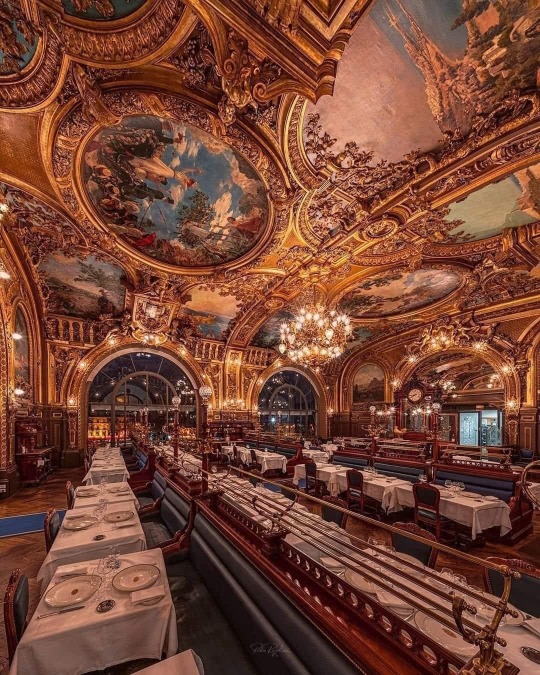
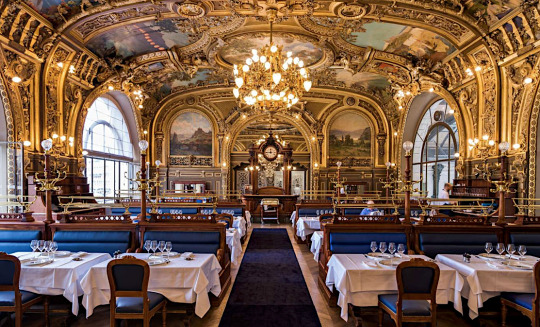
Restaurant Le Train Bleu, Gare de Lyon, Paris, France
Le Train Bleu ("The Blue Train") is a restaurant located in the hall of the Gare de Lyon railway station in Paris, France. It was designated a Monument Historique in 1972.
The restaurant was originally created for the Exposition Universelle (1900). Each ornate dining room is themed to represent cities and regions of France and they are decorated with 41 paintings by some of the most popular artists of that time.
Initially called "Buffet de la Gare de Lyon", it was renamed "Le Train Bleu" in 1963, after the famous train of the same name.
27 notes
·
View notes
Text
Transylvanie express (54)

Précédents épisodes
- Vous avez fait d’énormes progrès. Pouvez-vous faire un aller-retour, s’il-vous-plait ?
Je marchai, m’étonnant moi-même d’avoir retrouvé une certaine élégance dans ma démarche. Deux ans après mon accident cérébral, je pouvais marcher comme avant. Arrivé devant la porte du cabinet, je retournai m’assoir dans le fauteuil en cuir. Le médecin rit en écarquillant les yeux. Je l’accompagnai, heureux d’avoir survécu à une rupture d’anévrisme, surtout, d’avoir retrouvé tous mes moyens, même si mon sourire restait très légèrement figé sur le coin droit de mes lèvres.
Nous discutâmes de mon rétablissement, des méthodes employées par les différents services hospitaliers pour m’aider à retrouver mon état physique d’avant l’accident du train. Par habitude, je m’amusais à serrer puis desserrer le poing droit. J’aimais le voir en pleine action, en remuant les doigts ou le poignet ; c’était mon signe de victoire. J’allais me lever lorsque le docteur m’interpela.
- C’est quand même étrange que vous vous êtes réveillé avec des souvenirs qui ne sont pas les vôtres. J’ai questionné de nombreux confrères…Très peu ont eu de patients similaires.
- Je sais, répondis-je. Je reconnais que c’était très compliqué à vivre. Je savais que j’étais moi mais, je n’arrivais pas à sortir de la tête que tout n’était qu’un rêve. Le docteur Leroy m’a dit que c’était de la paramnésie ?
- C’est possible. Mais la paramnésie concerne un moment de déjà-vu. Dans votre cas, nous avons plutôt de la confabulation. Vous avez des souvenirs qui n’ont jamais eu lieu. Pourtant, votre description de Bucarest, les photos montrées pendant les tests, l’Orient-express, Venise…J’ai encore en tête votre récit…vous avez décrit ces lieux assez facilement alors que vous n’avez jamais mis les pieds en ces endroits.
- Et concernant la jeune femme qui m’a sauvé la vie ?
Il remonta ses lunettes tout en me souriant. J’avais appris qu’elle travaillait comme infirmière dans cet hôpital. Elle s’était assise près de mon siège et avait immédiatement remarqué mon état critique. Par la suite, elle venait me voir régulièrement quand j’étais dans le coma, pendant ses heures de pause. Mais, je n’eus jamais la possibilité de la remercier.
- Audrey a quitté notre service juste avant votre réveil. Sa mutation était programmée depuis longtemps, et depuis…je crois qu’elle est partie du côté de Lyon.
Je quittai le cabinet un peu déçu. Son assistante me salua avec un grand sourire. Je longeai ensuite les couloirs pour quitter cet hôpital que je commençai à connaitre presque par cœur. Malgré les quatre étages, je descendis les escaliers plutôt que de prendre l’ascenseur.
Dehors, je levai la tête pour admirer un ciel bleu dénué de nuages. J’inspirai un grand bol d’air. Il sentait la pollution, pourtant je l’appréciai comme un parfum rare. Puis, je quittai l’hôpital en passant par son parc. Une valise attendait chez moi que je la remplisse. J’avais profité d‘une reconnaissance de mon handicap pour prendre une formation. Et ma première journée commençait dans une semaine.
J’avais rendez-vous quelques jours avant le début des cours dans le centre de réadaptation professionnelle. Pour m’y rendre, je décidai de prendre le train ; le premier depuis mon accident. Je voyageai tranquillement en TGV jusqu’à Saint Brieuc. Il y avait de nombreux touristes et quelques vacanciers voulant profiter des embruns bretons. Puis, après une attente en gare, je pris un second train en direction de Lannion.
La locomotive démarra après l’annonce d’un contrôleur. Mais, une fois la gare quittée, je ressentis une étrange impression. C’était comme un appel provenant de l’arrière du train. Dès lors, je me retournai et, peut-être en raison de la présence de quelques passagers, je ressentis soudainement l’envie de m’isoler. Aussitôt, je me levai, pris ma valise et quittai le wagon pour me diriger vers le suivant.
Dehors, un paysage composé de bocages et de routes départementales défilaient sous un ciel radieux. Je marchai dans le couloir entre les sièges sans trouver une place qui me convenait. Dans la seconde, un homme reniflant constamment me dérangeait. Et dans la troisième, c’était une mère de famille incapable de calmer son fils de trois ans qui braillait à tout bout de champ.
Lorsque j’ouvris la porte du quatrième wagon, je ne la remarquai pas de suite. Elle était assise, la tête posée contre la vitre. Elle semblait dormir. La lumière du soleil réchauffait son doux visage tout en l’éclairant tel un ange qu’on voudrait étreindre. Ses cheveux longs ne cachèrent rien de son cou blanc. Il semblait si fragile, elle semblait si chétive, si faible. Je m’arrêtai à sa hauteur pour la regarder. Une boule pressait mon ventre. Je déglutis.
- Ludmilla ? murmurai-je.
Elle n’ouvrit pas les paupières. Sa poitrine gonflait et dégonflait tranquillement. Aussi, je m’assis sur la banquette opposée après avoir posé ma valise. Elle dormait toujours, la tête contre la vitre, son visage reflétant dans le carreau. Ses lèvres rouges rappelaient un souvenir dont je ne me suis jamais séparé. Elle inspira fortement. Puis, après quelques minutes, au premier arrêt, elle ouvrit les yeux.
La jeune femme regarda le quai. La gare était petite. On pouvait découvrir quelques entreprises, silos, fermes, voire des habitations pavillonnaires séparées par des champs ou de bosquets. Elle suivit du regard, un homme d’une trentaine qui monta dans une voiture de tête. Soudain, le train repartit sans annonce. Alors, elle observa notre wagon ; il n’y avait qu’elle et moi.
Lorsque ses yeux couleur noisette croisèrent mon regard, elle sourit poliment. Puis elle regarda de nouveau à travers la fenêtre, en plissant les yeux. Mais elle sentit mon insistance à l’observer. Alors, je me sentis obligé d’intervenir. Son parfum de vanille et de fleur d’oranger m’aida à franchir le pas.
- Excusez-moi. Cela peut paraitre ridicule mais j’ai l’impression de vous connaitre.
Elle resta muette tout en me dévisageant. Son sourire laissa place à un rictus fermé. Elle regarda autour d’elle. Je pouvais lire l’inquiétude et la peur dans ses pupilles. Elle était sur le point de se lever. Sa main agrippa un sac à dos posé à côté d’elle.
- Je ne cherche pas à vous draguer ni à vous faire peur, ajoutai-je
Mon culot faisait trembler mes membres. Je n’arrivais plus à contrôler mes mains ni mes jambes. Même ma voix devenait hésitante. Je cherchais mes mots, déglutissant afin de ne pas bafouiller. Elle comprit que je n’étais pas un danger. Peut-être un fou…
- Est-ce que par le plus grand des hasards, vous n’étiez pas infirmière en Picardie ?
Dès lors, son visage s’éclaircit. Elle ouvrit la bouche, étonnée. Ses yeux s’écarquillèrent. Elle rit soudainement tout en décontractant ses épaules.
- C’est vous ! dit-elle. Décidément, on ne se croise que dans les trains. Vous êtes sorti du coma ? J’en suis ravie…
Audrey ne s’arrêta plus de parler, me demandant combien de temps j’avais passé sur mon lit d’hôpital. Elle demanda si j’avais subi des séquelles, comment ma rééducation se passa. Elle insista à dire qu’elle était heureuse de me revoir en bonne santé. Elle parla tant, elle me posa tant de questions que j’en rougi. Je n’osai parler, lui dire qu’elle fut longtemps dans mes pensées, sous un autre prénom. Puis, je profitai d’un moment de silence.
- Merci, soufflai-je.
Elle rougit à son tour. Son sourire répondit simplement qu’elle avait juste fait son devoir. Le train s’arrêta à Guingamp. Elle se leva et avant de partir, elle embrassa ma joue.
- Prenez-soin de vous, murmura-t-elle.
Je la regardai partir et sortir du train. Sur le quai, ses cheveux voltigèrent légèrement. Elle tourna la tête, fit un signe de la main. Et le train démarra. Petit-à-petit, en même temps que son parfum, le souvenir de Ludmilla s’effaçait pour laisser place à un avenir plein de promesses. Et qui sait ? Peut-être la reverrais-je de nouveau ?
Alex@r60 – février 2023
12 notes
·
View notes
